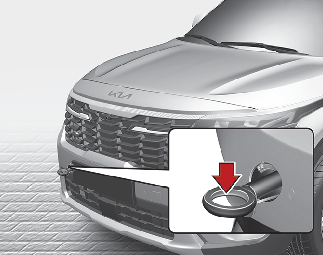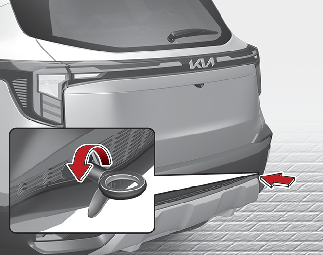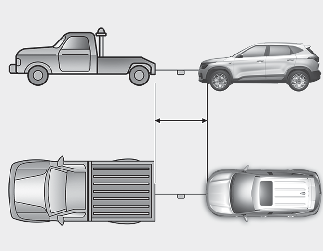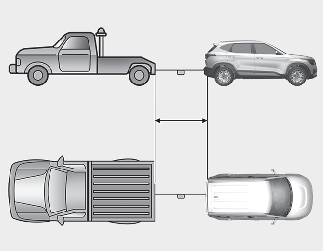Emergency towing


If towing is necessary, we recommend you to have it done by an authorised Kia dealer or a commercial tow truck service.
If towing service is not available in an emergency, your vehicle may be temporarily towed using a cable or chain secured to the emergency towing hook under the front (or rear) of the vehicle. Use extreme caution when towing the vehicle. A driver must be in the vehicle to steer it and operate the brakes.
Towing in this manner may be done only on hard-surfaced roads for a short distance and at low speed. Also, the wheels, axles, power train, steering and brakes must all be in good condition.
-
Do not use the tow hooks to pull a vehicle out of mud, sand or other conditions from which the vehicle cannot be driven out under its own power.
-
Avoid towing a vehicle heavier than the vehicle doing the towing.
-
The drivers of both vehicles should communicate with each other frequently.

-
Attach a towing strap to the tow hook.
-
Using a portion of the vehicle other than the tow hooks for towing may damage the body of your vehicle.
-
Use only a cable or chain specifically intended for use in towing vehicles. Securely fasten the cable or chain to the towing hook provided.
-
Accelerate or decelerate the vehicle in a slow and gradual manner whilst maintaining tension on the tow rope or chain to start or drive the vehicle, otherwise tow hooks and the vehicle may be damaged.
-
Before emergency towing, check if the hook is not broken or damaged.
-
Fasten the towing cable or chain securely to the hook.
-
Do not jerk the hook. Apply it steadily and with even force.
-
To avoid damaging the hook, do not pull from the side or at a vertical angle. Always pull straight ahead.

Use extreme caution when towing the vehicle.
-
Avoid sudden starts or erratic driving manoeuvres which would place excessive stress on the emergency towing hook and towing cable or chain. The hook and towing cable or chain may break and cause serious injury or damage.
-
If the disabled vehicle is unable to be moved, do not forcibly continue the towing. We recommend that you contact an authorised Kia dealer or a commercial tow truck service for assistance.
-
Tow the vehicle as straight ahead as possible.
-
Keep away from the vehicle during towing.
-
Use a towing strap less than 5 m (16 feet) long. Attach a white or red cloth (about 30 cm (12 inches) wide) in the middle of the strap for easy visibility.


-
Drive carefully so that the towing strap is not loosened during towing.
-
The driver must be in the vehicle for steering and braking operations when the vehicle is towed and passengers other than the driver must not be allowed to be on board.
Emergency towing precautions
-
Turn the ignition switch to ACC so the steering wheel isn't locked.
-
Place the transmission shift lever in N (Neutral).
-
Release the parking brake.
-
Press the brake pedal with more force than normal since you will have reduced brake performance.
-
More steering effort will be required because the power steering system will be disabled.
-
If you are driving down a long hill, the brakes may overheat and brake performance will be reduced. Stop often and let the brakes cool off.
-
The vehicle should be towed at a speed of 25 km/h (15 mph) or less within the distance of 20 km (12 miles). (For Manual transmission and Intelligent Manual Transmission vehicle)
-
To avoid serious damage to the automatic transmission, limit the vehicle speed to 15 km/h (10 mph) and drive less than 1.5 km (1 mile) when towing. (for Automatic Transmission and Intelligent Variable Transmission vehicle and Dual Clutch Transmission)

Automatic transmission/Intelligent variable transmission
-
If the car is being towed with all four wheels on the ground, it can be towed only from the front. Be sure that the transmission is in neutral. Be sure the steering is unlocked by placing the ignition switch in the ACC position. A driver must be in the towed vehicle to operate the steering and brakes.
-
Before towing, check the automatic transmission/intelligent variable transmission for fluid leaks under your vehicle. If the automatic transmission/intelligent variable transmission fluid is leaking, flatbed equipment or a towing dolly must be used.